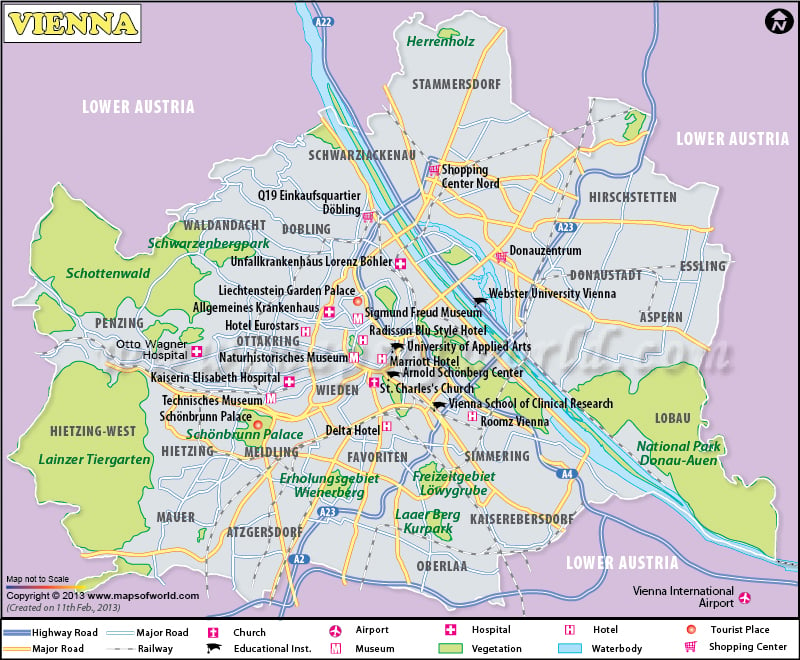About City
Vienna (German: Landkarte Wien) is the capital of Austria and the German name of this vast city is Wien. It is also known as the ‘city of music for its musical legacy as well as the ‘city of dreams, as it is the birthplace of the renowned psychoanalyst, Sigmund Freud. The city today covers an area of 414.65 sq km and had an approximate population of 1.96 million.
The earliest settlement in the area was a Roman fortification named Vindobona, which was erected in 45 BC by the Romans as a military outpost against the raiding Germanic tribes. The city had close ties with the Celtic people throughout the ages. In 1440, it became the resident city of the Hapsburgs and it grew to be the de facto capital of the Holy Roman Empire from 1483 to 1806. Since the 1840s, Vienna has played an important role in the politics of Europe. Today, it is home to a number of international organizations.
Geography
The city of Vienna is located in the northeastern part of Austria, on an extension of the Alps called the Vienna basin. The Danube runs in the northwest while the Danube canal runs through the southeast of the city. The famous Vienna woods lie to the west of the city. The average elevation of the city ranges from 151 to 524 meters. It consists of 23 municipal districts. Vienna enjoys a humid continental climate with warm summers and cold snowy winters. Besides, moderate precipitation is also recorded throughout the year.
How to reach (transport)
Being the headquarter of a number of international organizations Vienna is very well connected with the rest of the world. You can reach the city in the following ways:
- The Vienna International airport is served by several major airlines and is connected to important destinations in Europe, America, and Asia. The airport is situated just outside the city.
- Trains connect Vienna to all major destinations of Austria as well as with the surrounding countries and regions. Regular train connections are available from Zurich, Munich, Bratislava, and Budapest.
- Frequent buses also ply from the two main bus stations in Vienna to various destinations in Austria and the neighboring countries.
When to visit
The best time to go to Vienna is from April to October with July and August being the most crowded months. The best weather in the city is experienced during this time.
Culture (Fairs and Festivals) and Traditions
Vienna has long been known as the center of learning, culture, music, opera, etc. Some of the festivals which are celebrated in this city of rich cultural heritage are as follows:
- The Neujahrskonzert der Wiener Philharmoniker is the traditional New Year concert celebrated by the Vienna Philharmonic. Classical music is performed. The Blue Danube and the Radetzky March almost always mark the end of the concert.
- The Vienna Opera Ball is held on the last Thursday of the Carnival season in the State House and is one of the most exclusive events in the city.
- On 1st May, the May Day festival is celebrated in a city, which traditionally leans to the left. Parades by trade unions are a common sight on this day.
- The Life Ball held in late May is the biggest charity ball held for AIDS. It is a colorful affair including a fashion show by internationally reputed designers, a red carpet reception, and a night-long party.
- The Wiener Festwochen or Vienna Festival is celebrated with concerts, theaters, and operas throughout June in various locations of Vienna.
- The Vienna city marathon, which spans 40 km across the city, is held in early summer. Thousands of people take part in the marathon and supplement stalls are set up.
- The Vienna Christmas markets are held from the end of November and are marked by huge Christmas trees. Traditional goods are sold.
- The Imperial Ball is a regal event held in Hofburg and combines social splendor with culture.
Points of interest (places to visit)
The rich history and heritage of Vienna have resulted in a number of important places to visit in the city. Some of these are as follows:
- Schonbrunn Palace is the former summer residence of the Habsburgs. This vast baroque palace and its beautiful parks house artwork from various periods, and huge chandeliers, and are mostly decorated in the rococo style.
- The Vienna Hofburg was built at the center of the Austrian Empire and today it houses several collections of international standards, including the Ephesus Museum, a collection of ancient musical instruments, the globe and Esperanto museum, an art history museum, etc.
- The Treasury contains a stunning collection of regalia and jewels in the secular section and Christian religious images and objects in the ecclesiastical collection, and should not be missed.
- The Belvedere Palace is a beautiful baroque palace, which contains the largest collection of works of the artist Klimt as well as a large collection of medieval art.
- Vienna is a very green city and you can enjoy the marvels of nature at the Vienna Woods, the Stadtpark, City Hall Park, Volksgarten (a world heritage site), etc., are some of them.
Accommodation
Vienna provides a wide variety of accommodations for tourists. Those wanting a luxury stay can choose 5-star hotels like Le Meridien Wien, Ambassador, Radisson Blu, the Grand Hotel, etc. On the other hand, you can also plan your stay in 4-star hotels like Regina, Top Falkensteiner, Roomz, Alstadt, and Belvedere or 3-star hotels like Hotel Vienna. Additionally, there are also wide selections of budget hotels for tourists in Vienna like Hotel Capri, Hotel Ibis Wien Mariahilf, and Hotel Alpha.
